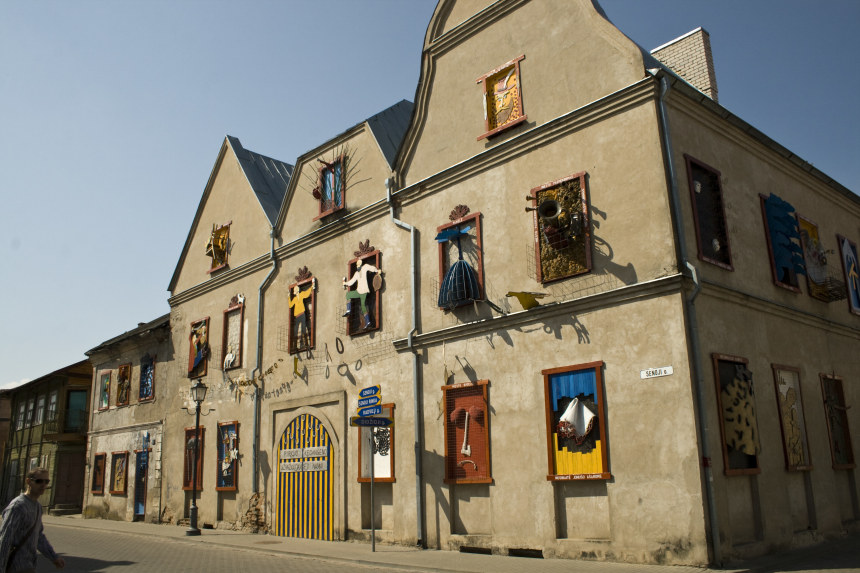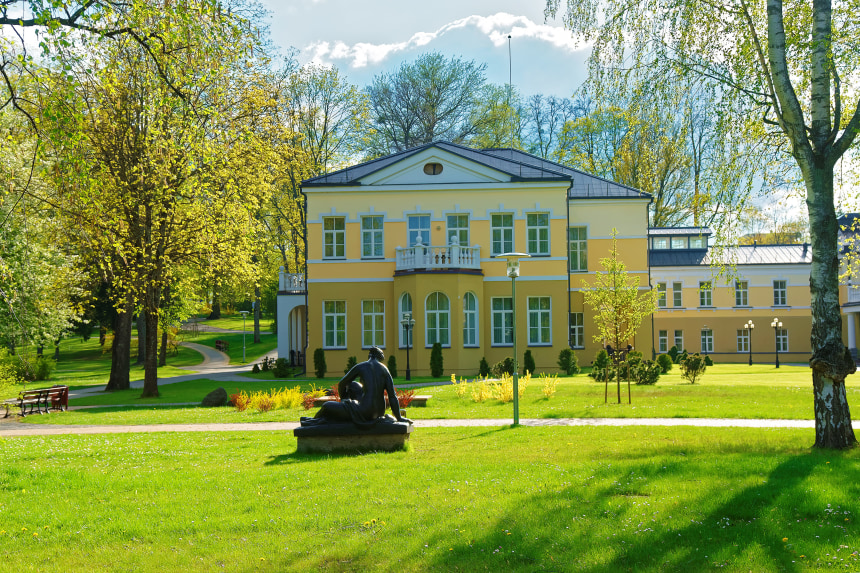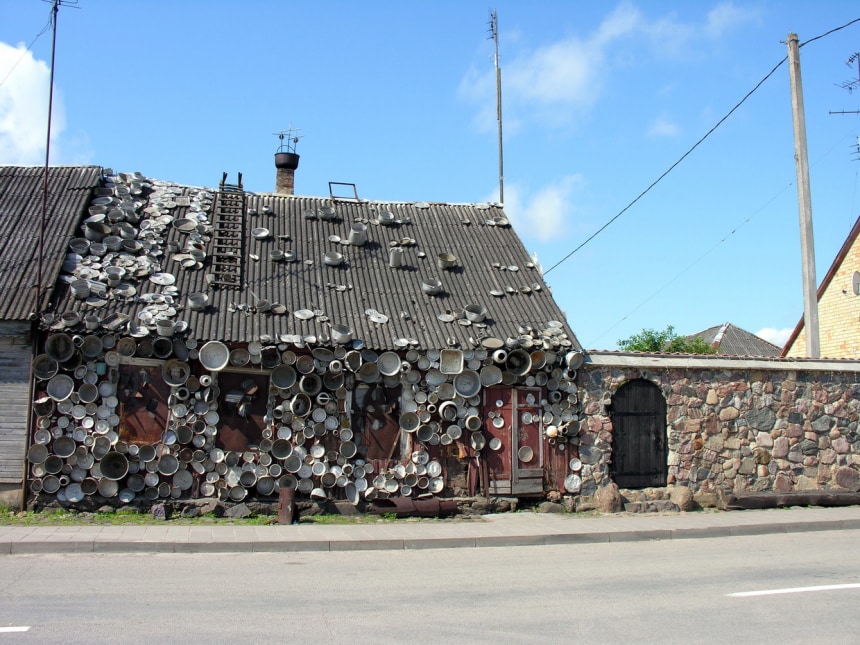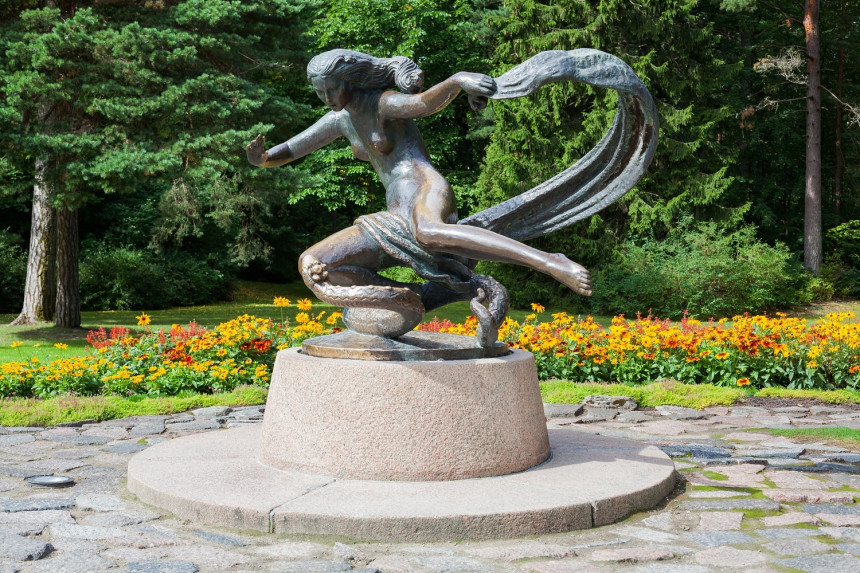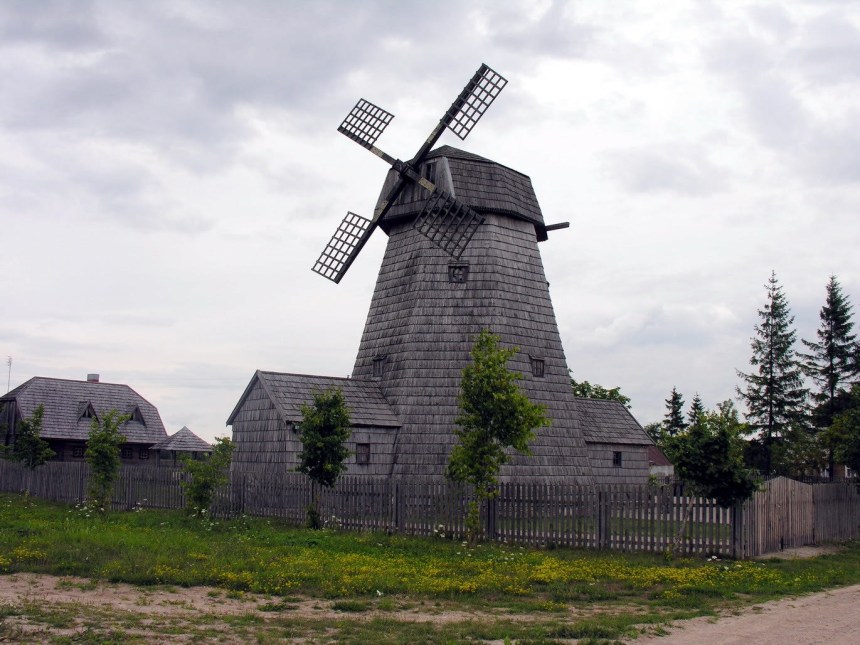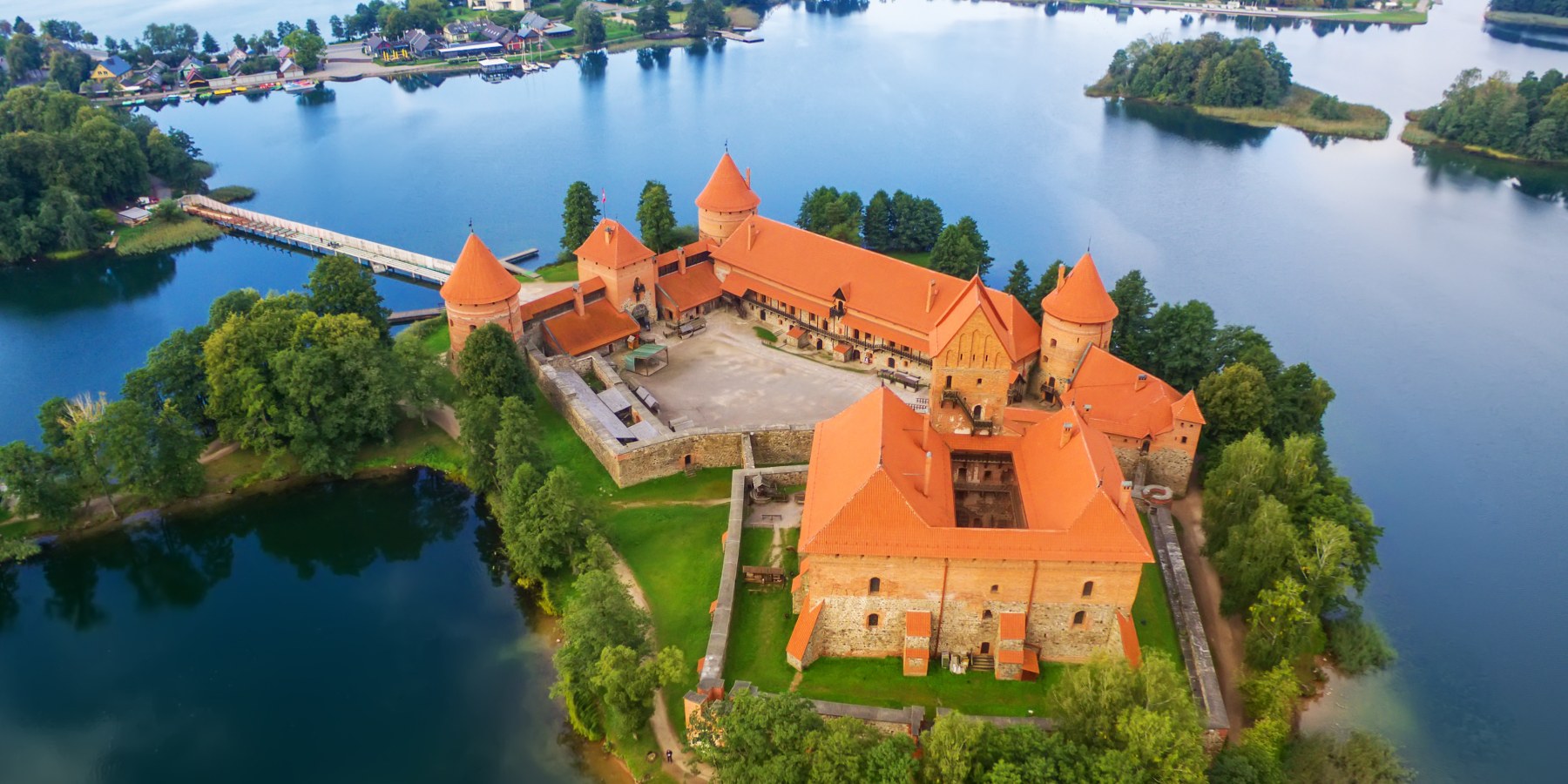Ross Cameron
Since gaining independence from the Soviet Union in 1990, Lithuania has become one of Europe’s quirkiest and most enchanting destinations. Sandwiched between Russia’s Kaliningrad Oblast, Belarus, and Latvia, the country is peppered with amber spangled beaches, sacred forests (a relic of the country’s rich pagan history) and picture-perfect villages dating from the era of the Russian Empire. While the country’s authentically medieval capital Vilnius has rightly become a mainstay for city breaks, the rest of the southernmost Baltic state remains charmingly off the beaten track and this Lithuania travel guide will show you the country’s unique destinations.
Kaunas: A modernist marvel
 Alongside the likes of Berlin, Tel Aviv, and Le Havre, Kaunas, Lithuania’s second city, is fast emerging as a must-visit destination for aficionados of modernist architecture. As the capital of the short-lived interwar Lithuanian Republic, Kaunas experienced a building boom like no other influenced by Bauhaus, Constructivism, and Rationalism. The result is a phantasmagoria of streamlined balconies and swooping plate-glass windows, all of which are tinged with Lithuanian folk art derived from the country’s pagan past. The city’s star attractions are the monumental Resurrection Church, the expressionistic rotunda of the Ciurlionis Art Museum and the cubist Great War Museum. What is more, the entire city center is laced with radical architecture and is in line to become a UNESCO World Heritage site. If modernism is not to your taste, then explore the 14th century gothic fortress, which was built to withstand the mighty Teutonic Order during the Baltic Crusades, the gilded baroque monastery of Pažaislis, where tour guides can explain the country’s fascinating path to Christianity, and the Ninth Fort, which is now a Holocaust memorial.
Alongside the likes of Berlin, Tel Aviv, and Le Havre, Kaunas, Lithuania’s second city, is fast emerging as a must-visit destination for aficionados of modernist architecture. As the capital of the short-lived interwar Lithuanian Republic, Kaunas experienced a building boom like no other influenced by Bauhaus, Constructivism, and Rationalism. The result is a phantasmagoria of streamlined balconies and swooping plate-glass windows, all of which are tinged with Lithuanian folk art derived from the country’s pagan past. The city’s star attractions are the monumental Resurrection Church, the expressionistic rotunda of the Ciurlionis Art Museum and the cubist Great War Museum. What is more, the entire city center is laced with radical architecture and is in line to become a UNESCO World Heritage site. If modernism is not to your taste, then explore the 14th century gothic fortress, which was built to withstand the mighty Teutonic Order during the Baltic Crusades, the gilded baroque monastery of Pažaislis, where tour guides can explain the country’s fascinating path to Christianity, and the Ninth Fort, which is now a Holocaust memorial.
Kedainiai: A picture-perfect example of Lithuania’s diverse history
 Kedainiai is a quintessentially Lithuanian town that perfectly encapsulates the country’s complex and fascinating history. The town is most famous for its traditional wooden architecture, which is best seen at the clapperboard 18th century Saint Joseph’s Church that also houses enthralling examples of Lithuanian folkloric art. Kedainiai is also famed for having the only freestanding minaret in Lithuania, which was built in an Oriental style to commemorate Russia’s victory over the Ottoman Empire in the Russo-Turkish War. Today, the minaret is a site of great importance to the local tartar people, an indigenous Muslim minority who settled in the Baltic following the Mongol invasions. Beyond the minaret and traditional church, the town was also a major center for Lithuania’s Jewish community before World War Two and today is one of the three remaining synagogues is a moving Holocaust memorial museum.
Kedainiai is a quintessentially Lithuanian town that perfectly encapsulates the country’s complex and fascinating history. The town is most famous for its traditional wooden architecture, which is best seen at the clapperboard 18th century Saint Joseph’s Church that also houses enthralling examples of Lithuanian folkloric art. Kedainiai is also famed for having the only freestanding minaret in Lithuania, which was built in an Oriental style to commemorate Russia’s victory over the Ottoman Empire in the Russo-Turkish War. Today, the minaret is a site of great importance to the local tartar people, an indigenous Muslim minority who settled in the Baltic following the Mongol invasions. Beyond the minaret and traditional church, the town was also a major center for Lithuania’s Jewish community before World War Two and today is one of the three remaining synagogues is a moving Holocaust memorial museum.
Druskininkai: Come for the healing waters and stay for Soviet history
 Hugging the Belorussian border and popular with day-trippers from what is often touted as Europe’s ‘last dictatorship’, Druskininkai is a spectacular spa town that is dominated with imposing Russian architecture, including a pastel-hued Orthodox Church. Many of the town’s palatial hotels date from Druskininkai's heyday as a popular resort for Russian royalty and offer healing thermal spa treatments that use water from nearby natural springs. While the healing waters are one of Lithuania’s most relaxing experiences, the most unusual thing to do in the town is to take a stroll around Grutas Park, which has become a graveyard for the country’s socialist-realist public art. Amongst the trees are countless busts and statues of Lenin while numerous other sculptures pay homage to the communist system and mock-watchtowers play Soviet marching songs. Grutas Park tour guides are also on hand to help visitors interpret the socialist realist art and give an insight into life under Soviet rule.
Hugging the Belorussian border and popular with day-trippers from what is often touted as Europe’s ‘last dictatorship’, Druskininkai is a spectacular spa town that is dominated with imposing Russian architecture, including a pastel-hued Orthodox Church. Many of the town’s palatial hotels date from Druskininkai's heyday as a popular resort for Russian royalty and offer healing thermal spa treatments that use water from nearby natural springs. While the healing waters are one of Lithuania’s most relaxing experiences, the most unusual thing to do in the town is to take a stroll around Grutas Park, which has become a graveyard for the country’s socialist-realist public art. Amongst the trees are countless busts and statues of Lenin while numerous other sculptures pay homage to the communist system and mock-watchtowers play Soviet marching songs. Grutas Park tour guides are also on hand to help visitors interpret the socialist realist art and give an insight into life under Soviet rule.
Žagare: Lithuania’s most peculiar town
 With barely 2000 inhabitants, Žagare is most famous for the Pan House. Located on the town’s quaint main street, the owner of this small cottage, Edmundas Vaiciulis, has decorated its external walls with hundreds of pots and pans alongside an array of other kitchen paraphernalia. What is more, Edumndas welcomes visitors into his home for short and typically eccentric tours of his unusual abode, which also show off his traditional woodcarving skills.
With barely 2000 inhabitants, Žagare is most famous for the Pan House. Located on the town’s quaint main street, the owner of this small cottage, Edmundas Vaiciulis, has decorated its external walls with hundreds of pots and pans alongside an array of other kitchen paraphernalia. What is more, Edumndas welcomes visitors into his home for short and typically eccentric tours of his unusual abode, which also show off his traditional woodcarving skills.
While the pan house has put Žagare on the map, the town is also home to the 18th-century manor house of Prince Platon Zubov, who was the last court favourite during the reign of the Russian Empress Catherine the Great. After a 2013 restoration, the spectacular manor house has been opened to visitors and guided tours of the luxurious interiors are available.
Orvidas Gardens: An open-air sculpture park that defied Soviet rule
 Inland from the amber rich seaside resort of Palanga, the Orvidas Gardens offer a unique look into Lithuania’s history of paganism, Christianity and 20th-century religious persecution. Built during the years of Soviet rule by a stonemason and a rogue Franciscan monk, the enchanting gardens are home to a dazzling array of religious monuments, which were rescued from churches facing Soviet repression, and wooden sculptures referencing Lithuania’s pagan history. During the era of communist rule, access to the park was blocked off, but today visitors are free to explore this wonderland of religious oddities.
Inland from the amber rich seaside resort of Palanga, the Orvidas Gardens offer a unique look into Lithuania’s history of paganism, Christianity and 20th-century religious persecution. Built during the years of Soviet rule by a stonemason and a rogue Franciscan monk, the enchanting gardens are home to a dazzling array of religious monuments, which were rescued from churches facing Soviet repression, and wooden sculptures referencing Lithuania’s pagan history. During the era of communist rule, access to the park was blocked off, but today visitors are free to explore this wonderland of religious oddities.
Žematija National Park: A Soviet nuclear bunker amidst enchanted forests
 Located in the misleadingly named Samogitian Highlands, Žematija National Park is a pastoral landscape of rolling wooded hills, icy blue lakes and pine-clad islands complete with its own nuclear bunker. Unsurprisingly, Lithuanian folklore suggests that the region is home to evil spirits and mystical creatures that lurk in the woods. Access to the park is through the lakeside town of Plateliai, which provides opportunities for water sports and sunbathing on isolated pebble beaches. Beyond this, the highlight of the park is the nuclear bunker, which was built by the Soviet Union in the 1960s and played a role in the Cuban Missile Crisis. At its height, the bunker contained enough firepower to flatten most major Western European cities but thankfully today it only houses the fascinating Cold War Museum. A visit to the bunker gives visitors an unrivalled opportunity to explore the underground silos that stored nuclear warheads.
Located in the misleadingly named Samogitian Highlands, Žematija National Park is a pastoral landscape of rolling wooded hills, icy blue lakes and pine-clad islands complete with its own nuclear bunker. Unsurprisingly, Lithuanian folklore suggests that the region is home to evil spirits and mystical creatures that lurk in the woods. Access to the park is through the lakeside town of Plateliai, which provides opportunities for water sports and sunbathing on isolated pebble beaches. Beyond this, the highlight of the park is the nuclear bunker, which was built by the Soviet Union in the 1960s and played a role in the Cuban Missile Crisis. At its height, the bunker contained enough firepower to flatten most major Western European cities but thankfully today it only houses the fascinating Cold War Museum. A visit to the bunker gives visitors an unrivalled opportunity to explore the underground silos that stored nuclear warheads.
“Over the past decade, Ross Cameron has travelled extensively across Europe, Southeast Asia, North America, North Africa, and the post-Soviet space. As someone who has a real passion for these regions of the globe, he is able to offer an expert opinion that highlights the best off the beaten track destinations.”
Image details and licenses
Kedainai: https://images.app.goo.gl/NpYuykQJTaTWLxZz6 (Laima Gūtmane, CC BY-SA 3.0), Žagare: https://images.app.goo.gl/oH64KzknLS48QimK9 (Algirdas, GNU Free Documentation License), Žematija: https://images.app.goo.gl/q8NEibo1WJsSyZRB7 (Algėrds, GNU Free Documentation License)

